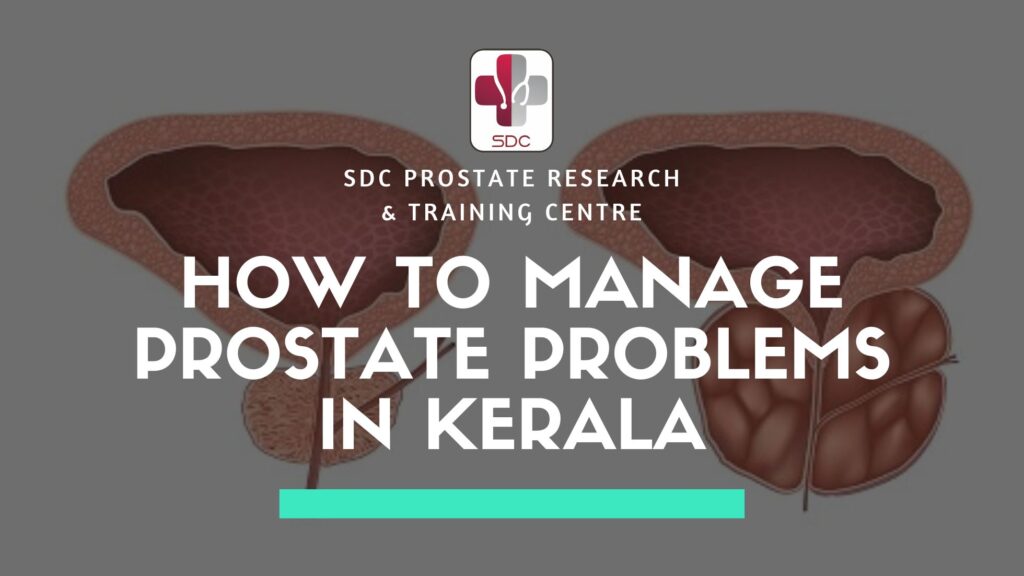
Men’s prostate health often gets overlooked until symptoms become uncomfortable or disruptive. This guide walks you through recognizing early warning signs—like nocturia and weak urine flow—and offers simple lifestyle tweaks (diet, fluid timing, exercise) to ease symptoms. We’ll also explore natural remedies, supplements, and when to consider medical therapy, from medications to minimally invasive procedures. Finally, you’ll learn about specialized care in Kerala, highlighting SDC PROSTATE RESEARCH & TRAINING CENTRE’s cutting-edge treatments like REZUM and UroLift.
Understanding the Prostate and Common Problems
The prostate is a small, walnut-sized gland in men that produces fluid to nourish and transport sperm.
As men age, the prostate can grow—a condition called benign prostatic hyperplasia (BPH)—leading to pressure on the urethra and urinary symptoms.
Other prostate issues include prostatitis (inflammation or infection) and prostate cancer, which require distinct diagnostic and treatment approaches.
Recognizing Symptoms
Frequent and Urgent Urination
Feeling the need to urinate more than eight times a day or suddenly rushing to the bathroom are common BPH symptoms.
Nocturia (Nighttime Urination)
Waking up multiple times at night interrupts sleep and can signal prostate enlargement; cutting back on fluids and caffeine before bed helps reduce nocturia.
Weak Stream and Hesitancy
A weak, dribbling stream or difficulty starting urination often points to prostate pressure on the urethra.
Pain or Discomfort
Prostatitis can cause pelvic pain, burning during urination, or flu-like symptoms if infection is present.
Lifestyle and Diet Changes
Adopting healthy habits can significantly ease mild prostate symptoms and may slow disease progression.
Follow a Mediterranean-Style Diet
A diet rich in fruits, vegetables, whole grains, and healthy fats (olive oil, nuts) supports prostate health and may reduce BPH risk.
Include tomatoes (rich in lycopene), fatty fish (omega-3s), and cruciferous vegetables (broccoli, cauliflower) for their antioxidant benefits.
Mind Your Fluid Intake
Cut down on fluids—especially caffeine and alcohol—two hours before bedtime to minimize nighttime trips to the loo.
Sip water steadily throughout the day rather than gulping large amounts at once, which can overwhelm the bladder.
Stay Active and Maintain a Healthy Weight
Regular exercise—walking, swimming, yoga—helps regulate hormones and eases urinary symptoms; aim for at least 30 minutes a day.
Maintaining a BMI under 25 may reduce symptom severity, as excess weight can increase pressure on the bladder.
Bladder Training and Pelvic Floor Exercises
Practice “double voiding”—urinating, then waiting a minute and trying again—to fully empty the bladder.
Pelvic floor (Kegel) exercises strengthen the muscles controlling urine flow; hold each contraction for five seconds, release, and repeat 10–15 times, three times daily.
Natural Remedies and Supplements
While not a substitute for medical care, certain supplements may complement your routine. Always discuss with your doctor before starting any.
Pumpkin Seed Oil: Rich in zinc and healthy fats, it may help shrink the prostate and ease symptoms.
Beta-Sitosterol: A plant sterol that may improve urine flow and reduce nighttime frequency.
Pygeum Africanum: Extract from African cherry bark shown to ease urinary discomfort in some studies.
Saw Palmetto: Widely marketed but studies show mixed results, often no better than placebo.
Green Tea & Lycopene: Antioxidants that may support overall prostate health; incorporate green tea daily and lycopene-rich foods like tomato sauce.
Medical Treatments and Medications
When lifestyle changes aren’t enough, physicians may recommend:
Alpha-Blockers
Drugs like tamsulosin relax prostate and bladder neck muscles, improving urine flow within days to weeks.
5-Alpha Reductase Inhibitors
Finasteride and dutasteride shrink the prostate by blocking hormone conversion; effects take 6–12 months and may carry sexual side-effect risks.
Antibiotics for Prostatitis
Bacterial prostatitis requires a course of antibiotics; chronic cases may need extended therapy up to 6–12 weeks.
Intermittent Catheterization
For significant urinary retention, self-catheterization relieves the bladder; proper technique minimizes infection risk.
Minimally Invasive Procedures Available in Kerala
When medications fall short, these day-care interventions offer symptom relief with faster recovery than traditional surgery.
Water Vapor Thermal Therapy (Rezum): Steam injections destroy excess prostate tissue; preserves sexual function.
Prostatic Urethral Lift (UroLift): Implants that retract prostate lobes, widening the urethra without cutting tissue.
Prostatic Artery Embolization (PAE): An angiographic procedure that reduces prostate blood flow, shrinking the gland over weeks.
Holmium Laser Enucleation (HoLEP) & ThuFLEP: Laser techniques that remove prostate tissue with minimal bleeding and quick recovery.
Specialized Care at SDC PROSTATE RESEARCH & TRAINING CENTRE, Thrissur
For men in Kerala seeking expert urological care, SDC PROSTATE RESEARCH & TRAINING CENTRE in Thrissur offers the full spectrum—from diagnostics (PSA testing, ultrasound, urodynamics) to advanced therapies like REZUM, UroLift, PAE, HoLEP, and ThuFLEP. Their experienced team, led by Dr. Jithunath M. R., provides personalized treatment plans, ensuring the latest minimally invasive options are available close to home.
When to Seek Professional Help
If lifestyle tweaks and over-the-counter remedies don’t ease your symptoms within a few weeks—or if you experience blood in urine, severe pain, or difficulty passing any urine—consult a urologist promptly to rule out serious conditions like prostate cancer.
Conclusion
Managing prostate problems in Kerala starts with understanding your symptoms and embracing simple lifestyle changes—diet, fluid timing, exercise, and pelvic floor work. Natural supplements may offer extra support, but medical therapies (medications or minimally invasive procedures) provide reliable relief when needed. And for specialized, state-of-the-art care, SDC PROSTATE RESEARCH & TRAINING CENTRE in Thrissur stands ready to guide you toward better urinary comfort and a higher quality of life.
Frequently Asked Questions
1. What lifestyle changes can help manage prostate problems, and how does SDC PROSTATE RESEARCH & TRAINING CENTRE support these?
Adopting regular exercise and a balanced diet rich in fruits, vegetables, whole grains, and healthy fats can ease urinary symptoms and slow prostate enlargement. SDC PROSTATE RESEARCH & TRAINING CENTRE offers personalized counseling on diet, fluid timing, and activity plans to optimize your prostate health.
2. How does SDC PROSTATE RESEARCH & TRAINING CENTRE diagnose BPH and other prostate conditions?
They use PSA blood tests, digital rectal exams (DRE), ultrasound imaging, and urodynamic studies to accurately assess prostate size and function before recommending treatment.
3. Which natural remedies or supplements does SDC PROSTATE RESEARCH & TRAINING CENTRE recommend for prostate wellness?
Supplements like pumpkin seed oil, beta-sitosterol, and Pygeum africanum bark extract may help reduce urinary frequency and improve flow; SDC PROSTATE RESEARCH & TRAINING CENTRE reviews each patient’s health profile before advising any supplement regimen.
4. When should men in Kerala seek medical help at SDC PROSTATE RESEARCH & TRAINING CENTRE for prostate issues?
If you experience bothersome symptoms such as frequent nighttime urination, weak stream, or pelvic pain that persist despite lifestyle tweaks, consult a urologist at SDC PROSTATE RESEARCH & TRAINING CENTRE to rule out serious conditions.
5. What minimally invasive treatments are available at SDC PROSTATE RESEARCH & TRAINING CENTRE for prostate enlargement?
They offer Rezum™ Water Vapor Therapy, which uses steam to shrink excess tissue, and the UroLift® System, which places tiny implants to retract prostate lobes and open the urethra without cutting or heating tissue.
6. How does follow-up care work at SDC PROSTATE RESEARCH & TRAINING CENTRE after prostate treatment?
Post-procedure, SDC PROSTATE RESEARCH & TRAINING CENTRE schedules regular PSA monitoring and urinary flow tests to track recovery and ensure long-term success.
7. Are prostate cancer screenings available at SDC PROSTATE RESEARCH & TRAINING CENTRE, and when should I get tested?
Yes—SDC PROSTATE RESEARCH & TRAINING CENTRE offers PSA testing and digital exams; most guidelines recommend baseline screening around age 50 (or earlier with risk factors), with annual checks as advised by your urologist.
8. What diet recommendations does SDC PROSTATE RESEARCH & TRAINING CENTRE give to manage prostate problems?
They encourage a plant-forward diet—tomatoes for lycopene, fatty fish for omega-3s, cruciferous vegetables, whole grains, and green tea—to leverage antioxidants and anti-inflammatory benefits for prostate health.
9. Can SDC PROSTATE RESEARCH & TRAINING CENTRE help me learn pelvic floor exercises and bladder training?
Absolutely—SDC PROSTATE RESEARCH & TRAINING CENTRE teaches Kegel routines (contracting pelvic floor muscles for 3–5 seconds, relaxing, and repeating) and bladder-training techniques to improve control and reduce urgency.
10. What is the expected recovery time after minimally invasive prostate procedures at SDC PROSTATE RESEARCH & TRAINING CENTRE?
Most patients resume normal activities within 24–48 hours after Rezum™ Therapy with symptom relief in a few weeks; those undergoing UroLift® typically go home the same day and report improved flow in under two weeks.
